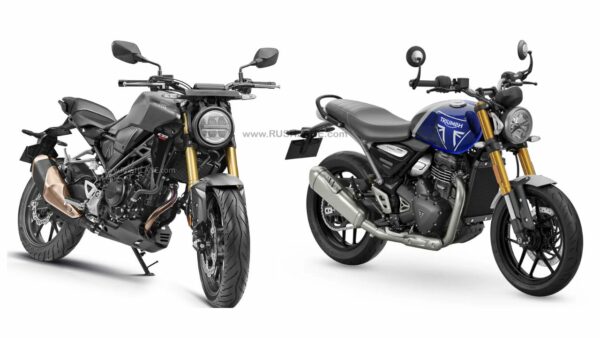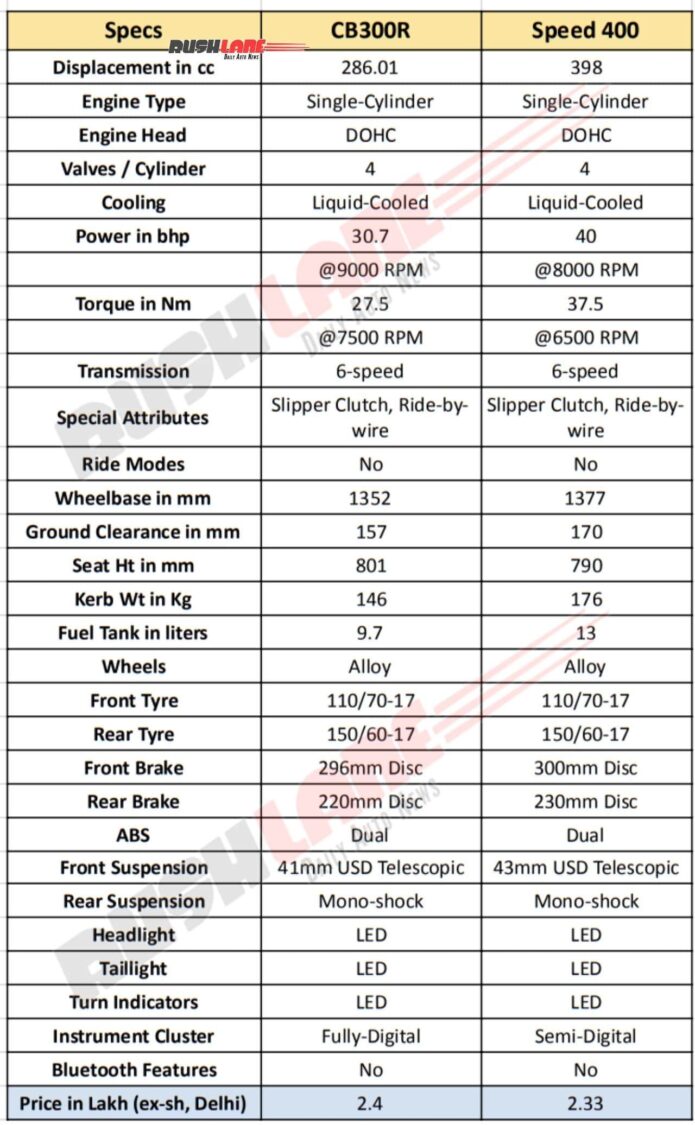
Where Triumph Speed 400 trounces the Honda CB300R in terms of performance figures, the latter strikes back being 30 kg lighter
At Rs. 2.33 lakh (ex-sh), Triumph Speed 400 is quite VFM when compared to the likes of TVS Apache RTR 310, Harley-Davidson X440. Performance it brings for the price point along with the cool neo-retro cafe racer design is perfect. However, Honda just crashed Triumph’s party by slashing price of its CB300R neo-retro cafe racer bike.
Honda CB300R Vs Triumph Speed 400
This is a rather surprising rivalry that spawned due to the recent price revision that Honda announced with 2023 CBR300R. With this price revision, 2023 Honda CB300R now costs Rs. 2.4 lakh (ex-sh) and knocks on the door where Triumph Speed 400 has had a secure footing.
Even though there are a few more bikes in this price bracket, they don’t share enough attributes between them to be properly comparable. Both Speed 400 and CB300R are neo-retro cafe racer machines, they have comparable kit and hardware and now they have even come close where pricing is concerned.
In terms of powertrains, Honda’s CB300R falls short as it displaces just 286.01cc as opposed to 398cc of Speed 400. Both engines are liquid-cooled, get a DOHC setup, a 4V head and bear a single-cylinder architecture. CB300R makes 30.7 bhp of peak power at 9000 RPM and 27.5 Nm of peak torque at 7500 RPM.

Not only does Speed 400 make more power and torque at 40 bhp and 37.5 Nm, peak performance comes earlier in the rev range as opposed to Cb300R. Both get slipper clutch, ride by wire and a 6-speed gearbox. Both don’t have any ride modes. So, that’s it? Triumph wins?
CB300R weighs 30 kg less than Speed 400
The shift in gravity in this comparison is in the form of weight. Where Triumph Speed 400 weighs 176 kg, Honda CB300R tips the scale at just 146 kg. Which is a fricking 30 kg advantage that Honda boasts. Not only does this enable spritely performance, but it allows better dynamics too.
Less weight is an absolute boon for first time riders that began their motorcycling journey with a premium single-cylinder bike. Honda has a smaller wheelbase and the lower weight should enable sharper cornering too. Other than that, both Triumph Speed 400 and Honda CB300R get similar attributes.
For example, both get all-LED lighting, single disc brake setup at both ends, dual channel ABS, comparable disc brake sizes, 17-inch alloy wheels, 110-section front tyre, 150-section rear tyre, USD telescopic front fork and rear mono-shock setup and more. Honda offers a fully-digital instrument cluster, while Triumph offers semi-digital.
Speed 400 has a larger 13L fuel tank as opposed to 9.7L of CB300R. Also, Speed 400 promises a 10,000 mile (16,000 km) service interval and lower service cost when compared to a 350cc Royal Enfield.
Triumph Speed 400 is still the value champ in this comparo, offering more oomph for Rs. 7,000 less than CB300R. But the lightness along with quality and trust associated with Honda badge are highlight features of CB300R.

